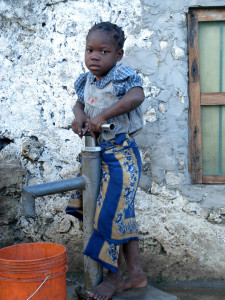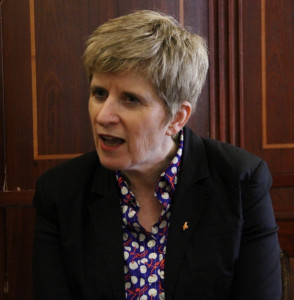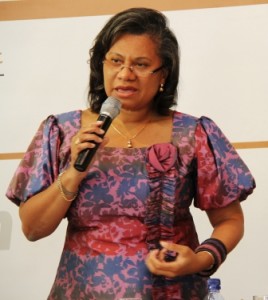Gilmore discussed the impact on African youth of the last two decades of action on sexual and reproductive health and equal access to education [...]]]>

Credit: Mercedes Sayagues/IPS
“The future is today aged 10 and it’s an adolescent girl,” Kate Gilmore, deputy executive director of the United Nations Population Fund (UNFPA), said in an interview with IPS in Johannesburg.
Gilmore discussed the impact on African youth of the last two decades of action on sexual and reproductive health and equal access to education for girls, which are assessed in the International Conference on Population and Development (ICPD) Beyond 2014 Global Report.
The report was released on Feb. 12, the anniversary of the 1994 ICPD, where 176 countries agreed on a 20-year Programme of Action, also known as the Cairo Consensus. This is a good opportunity to assess the gains and challenges of the ICPD, said Gilmore.
Q: What has the global community achieved for young people in the last 20 years?
A: One of the really groundbreaking outcomes of the ICPD was the commitment to sexual and reproductive health, making it a human rights project and not a population control project, not a project about controlling women’s fertility but a project about empowering women to be in charge of their bodies. It was a really cool shift that created transformation in public policy.
The past 20 years has also seen 1,2 billion people lifted out of poverty, a 42 percent decline in maternal mortality, and 90 percent of children passing through primary school.
Q: What economic gains have been made in Africa?
A: We have not made much economic gains in terms of addressing disparities.The gap between the rich and poor has gotten bigger within countries and between countries.
The data we were able to examine, covering the period between 2000 and 2008, just before the most recent economic crisis, showed the world had experienced and benefited from economic growth. But 50 percent of the economic growth went to less than five percent of the world’s population and economic growth gave no benefit to ten percent of the world’s population, who are the poorest.
UNFPA is calling on Member States to commit to legislative and policy reform that says there is no place for inequality, discrimination and marginalisation in our society.
Q: HIV prevalence in adolescent girls has not decreased in the past 20 years. Has the ICPD failed adolescent girls in this regard?
A: Yes, but this is a shared failure, because states also have a responsibility. We have failed to protect our girls from early marriage, from gender based violence and from early pregnancies. Governments need to realise that, unless we change the trajectory of adolescent girls on their journey to adulthood, there will be no development that is more sustainable, inclusive and resilient.
When you change the trajectory of the adolescent girl, everything changes in a community. Looking at all the data from the past 20 years, we can see clearly that what happens to the adolescent girl in the next 15 years, that is what will make or break the future.
Q: How do we invest in young people?
A: By engaging with governments and saying, let us have a look at your national strategies and priorities, let us give you access to the best technical wisdom. We also look into the best way to get the best benefit from having a healthy young population: changing health systems, improving education systems, creating spaces for young people to hone their entrepreneurial skills in new sectors.
Q: How has Africa addressed adolescent sexual and reproductive health?
A: Through deliberations of the African Union, we have seen increasing attention to sexual and reproductive health and rights. However, I do believe it has not always been identified as a young person’s issues. But, as governments have become sophisticated in the analysis of demographic realities, it has become clearer that when we talk about maternal mortality, HIV and AIDS, unsafe abortion, early marriage, fistula, and female genital mutilation, we are talking about young people.
Q: Why is it important to address the youth bulge in Africa?
A: Africa is a young person’s continent. The median age in most countries is 30 years and in Africa it is 20 years. If you want to make the youth cohort the fuel for driving economic prosperity, social stability and good governance, give them access to education and keep them healthy.
]]>
** Dr. Julitta Onabanjo is the Regional Director for UNFPA’s East and Southern Africa region, stationed in Johannesburg
Recently, a 14-year-old girl from Kakamega County in Kenya gave birth to a set of triplets, fathered by a boy aged 16. The phenomenon of children having babies is not limited to Kenya; it occurs [...]]]>
** Dr. Julitta Onabanjo is the Regional Director for UNFPA’s East and Southern Africa region, stationed in Johannesburg
Recently, a 14-year-old girl from Kakamega County in Kenya gave birth to a set of triplets, fathered by a boy aged 16. The phenomenon of children having babies is not limited to Kenya; it occurs in many African countries.
Fifteen-year-old Ida, from Mozambique, became pregnant when she was 13 years old while 25-year-old Mariel, from Madagascar, got pregnant when just 13 years.
Each year, 7.3 million girls under the age of 18 give birth in developing countries — of these, around 2 million are under 15.
As an African mother, I would not like my daughter, or niece – or any young girl, for that matter – to get pregnant at an early age, not just because it would compromise their life opportunities, but also because medically and psychologically, teenage pregnancy poses high risk for both the adolescent girl and her child.
The trend of children giving birth to children should not be allowed to continue. This is why UNFPA’s State of World Population 2013: Motherhood in Childhood, launched this week, addresses the challenge of adolescent pregnancy head on.
The social drivers of adolescent pregnancy in our society are well known. They include impoverishment, social marginalization and child marriage. Others are limited choices and opportunities in life, or inadequate access to sexual and reproductive health, including contraceptive information and services.
As the report notes, “Every day, 20,000 girls below age 18 give birth in developing countries,” most of them from lower-income rural households. Many of these girls are also nutritionally deficient.
Pregnancy has enormous consequences for a young girl. Broadly speaking, it alters the course of her life, seriously affecting her health, education and income-earning potential.
Pregnancy and childbirth are the leading cause of death for adolescent females in developing countries, resulting in 70,000 deaths annually. Likewise, health problems such as obstetric fistula are more likely if a girl becomes pregnant too soon after reaching puberty.
When girls leave school due to pregnancy or for any other reason, their economic prospects are jeopardised, while their opportunities in life might be severely truncated.
A call to action
Thus, addressing motherhood in childhood requires institutional and community responses, as well as individual commitment. Programmes that target the girl child need to take into account the broader social drivers of the problem.
For instance, we need to address the underlying factors of adolescent pregnancy, including gender inequality, poverty, sexual violence and coercion, child marriage, social pressures, exclusion from education and lack of job opportunities. We must also address the negative attitudes and stereotypes about adolescent girls that contribute to the problem.
An important area of concern is inadequate access to comprehensive sexuality education and youth friendly information and services where their privacy and confidentiality is maintained. Teenagers need to be fully informed on how to protect themselves from unplanned pregnancies.
Adolescents and young people also need holistic development, which focuses on creating a safe and supportive environment for accessing information, services and platforms for participation and advocacy.
Communities, including religious and traditional leaders, school authorities and social protection officers should work to protect the rights of girls in teen pregnancy and child marriage. This is where some of the conditions, norms, values and structures that perpetuate adolescent pregnancies can be changed.
Specifically, our boys and men should respect the rights of adolescent girls and not cajole or coerce them into sex. It is absolutely critical that our young people are enabled to protect themselves against sexually transmitted infections, especially HIV – the second main cause of death among young women in Africa.
And as so many adolescent girls die from unsafe abortions when choosing to terminate their unplanned pregnancies, they must be granted access to modern contraceptive and safe abortion services.
All said, our children should not be having babies. It is our collective duty to ensure that adolescent and young people achieve their full potential through quality education, health information and services, gainful employment and being protected from unplanned pregnancies and child marriage.
Now is the time to harness and invest into the resilience of our young people to achieve great dividend for the African continent.
]]>Two weeks ago I met Jeanne and Hubert Mwangaza in a poor suburb of Lubumbashi, Democratic Republic of Congo (DRC), where I was on a video assignment with UNICEF. Hubert could not wait to tell me – on camera – [...]]]>
Two weeks ago I met Jeanne and Hubert Mwangaza in a poor suburb of Lubumbashi, Democratic Republic of Congo (DRC), where I was on a video assignment with UNICEF. Hubert could not wait to tell me – on camera – how proud he is that all his children are HIV negative. Him and his wife are both HIV positive.
When they met, Jeanne had given up any hope to have children. Hubert convinced her that prevention of mother-to-child transmission could give them HIV-negative babies.
He accompanied Jeanne to ante-natal visits and checked that she took her antiretroviral medication regularly. He was with her during each birth of their three daughters and when they were tested for HIV.
For her last-born, Marie, Jeanne was put on the new revolutionary one-pill-a-day antiretroviral treatment known as life-long treatment.
Women on this new regimen are able to breastfeed their babies safely for six months, provided that they adhere to the treatment. Marie has to take another HIV test at six and 18 months, but Hubert is confident that his little girl, like her elder sisters, is born without the virus.
Only a few years ago, this family’s story would have been the exception rather than the rule. Today, Botswana, Ghana, Namibia and Zambia have virtually eliminated new HIV infections in children, and a few more countries in Africa are close behind them.
However, children’s access to antiretrovirals remains unacceptably low – only three in 10 eligible children receive HIV treatment in many of the most affected countries.
Dramatically improving these numbers is among the top goals for the 22 priority countries targeted by the Global Plan that aims to elimination new HIV infections among children by 2015 and keeping their mothers alive.
Securing child health is only a fraction of the job to be done. Too many women are getting infected and not all pregnant women living with HIV are accessing life-saving treatment.
Between 2009 and 2012, there has been no decrease in the number of new HIV infections among women. We need to redouble efforts in preventing HIV among adults- and especially young women- through a combination of safer sexual behaviour, voluntary medical male circumcision and use of antiretroviral therapy among discordant couples.
Voluntary family planning services for all women, including women living with HIV, can prevent unwanted pregnancies and help reduce new HIV infections among children. Young women in particular should have access to voluntary planning and comprehensive information about preventing HIV.
In the next months, Inter Press Service Africa, in collaboration with UNAIDS, Unicef and UNFPA, will tell many stories like Jeanne and Hubert’s — stories of courage and resilience that will rekindle our hope that a generation of babies born without HIV to healthy mothers living with HIV is around the corner. Other stories will highlight challenges to solve if we are to turn that corner by 2015.
The Countdown to Zero New HIV Infections project explores community, policy and expert efforts across Africa to achieve these goals through in-depth feature stories, portraits and testimonies.
Follow the stories here: http://www.ipsnews.net/news/projects/countdown-to-zero/
Enter the conversation:
Facebook: www.facebook.com/countdowntozeroHIV
Twitter: @ZeroNewHIV
]]>

